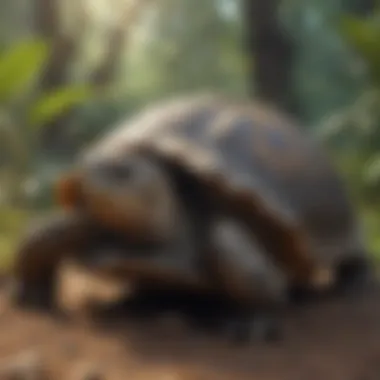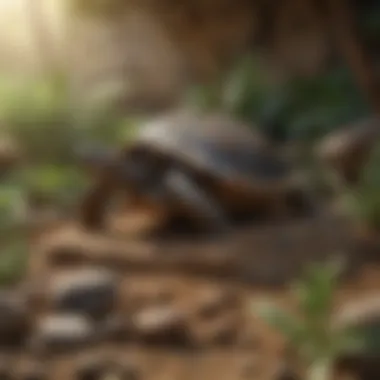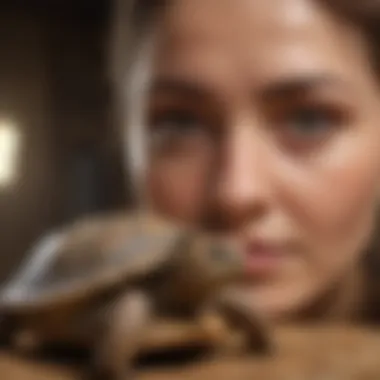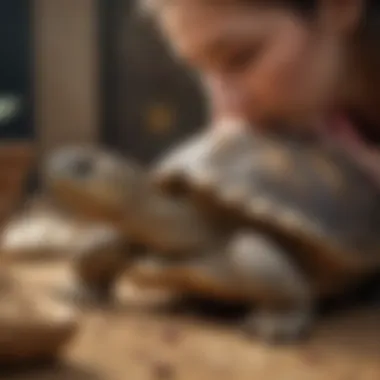The Ultimate Guide to Choosing and Caring for Tortoises


Intro
Purchasing a tortoise can be enriching but requires serious consideration. Every tortoise species presents different needs and responsibilities. It is important, before making a decision, to equip oneself with valuable information. A prospective buyer must know enough about the tortoise's habitat, particular dietary needs, and ethical matters surrounding ownership.
In this guide, we explore multiple aspects of tortoise ownership:
- Species Understanding: Get acquainted with the many tortoise species, their uniqueness, and what living with them entails.
- Habitat Requirements: Learn about the spaces that best replicate their natural environments.
- Care Perspectives: Uncover the necessary care practices that lead to the well-being of these reptiles.
- Ethical Implications: Evaluate the significance of responsible ownership for conservation efforts.
This guide aims not only at informing potential tortoise owners but also engendering a sense of responsibility that might contribute positively to the conservation of tortoise populations and their habitats.
Tortoise Species
Different tortoise species possess vastly varying needs and characteristics. It’s essential to study and identify which species best aligns with your lifestyle and capability as a pet owner. Common species to consider include:
- Russian Tortoise: Hardy and well-suited for beginner owners due to its adaptable nature.
- Sulcata Tortoise: Known for its size and long lifespan, this species needs significant space and daily interaction.
- Greek Tortoise: Small and engaging, they require moderately-sized enclosure environments and a balanced diet.
Familiarizing one’s self with species traits can determine the level of compatibility between the animal and owner.
Habitat Needs
Creating a harmonious living space greatly benefits both tortoises and owners. Factors include:
- Space Requirements: Enclosure size depends on the species. Larger tortoises, such as the Sulcata, need room to roam.
- Environment Construction: Substrates should mimic natural habiitat and allow healthy digging behaviors. Basking hotspots are crucial for their metabolism.
- Temperature Control: Proper thermoregulation through heating lamps best serves the species' health.
Additionally, specific plants and hiding spots enhance the tortoise’s retreat and leisure experience.
Ethical Ownership
Before making a purchase, consider the ethics surrounding tortoise ownership. Responsible tortoise keeping includes:
- Sourcing from Reputable Breeders: Overreliance on wild capture can lead to habitat depletion. Choosing breeders who focus on captive-bred populations is preferable.
- Legislation Awareness: Be aware of ownership laws related to specific tortoise species, as some may require permits.
- Long-term Engagement: Life with a tortoise requires time and commitment, given that they can live for decades.
Owning a tortoise goes beyond just personal enjoyment; it involves understanding core ethical topics related to species preservation and welfare.
The End
In summary, anyone contemplating the purchase of a tortoise must extensively evaluate various preliminary factors. Exploring species characteristics, habitat requirements, and ethical considerations form the foundation of responsible tortoise ownership. Equip yourself adequately before committing, and underscore the profound aspect of conservation in enhancing the lives of tortoises - both in captivity and the wild.
Understanding Tortoise Species
Understanding tortoise species is crucial when considering purchasing one as a pet. Each species has unique characteristics, care needs, and ideal environments. Knowledge about these species helps avoid surprises down the line when bringing a tortoise into your home.
Knowing the differences between tortoise types means the buyer can make a more informed choice. It prevents overwhelmed feelings regarding appropriate habitat setups or dietary considerations later. Additionally, some tortoises have long lifespans, making clock ticking towards responsibly caring for a living being.
Popular Tortoise Species for Pets
Certain species are popular as exotic pets due to their temperament and adaptability. Some of the most common tortoise species kept as pets include:
- Russian Tortoise (Testudo horsfieldii): Often small and friendly, these tortoises are adaptable and well-suited to varied habitats.
- Mediterranean Spur-thighed Tortoise (Testudo graeca): Medium in size, known for a beautiful shell, and needs adequate space for roaming.
- Sulcata Tortoise (Centrochelys sulcata): Large and active, they require extensive outdoor enclosures.
- Egyptian Tortoise (Testudo bacterphila): Smaller and generally more delicate, they thrive in specific environmental needs.
Understanding which species aligns with your capacity helps in owning a tortoise successfully.
Differences in Size and Lifespan
Sizes can vary significantly among tortoise species. Some can reach lengths of over three feet, while others may remain small enough to fit in your hand. The Sulcata can grow very large, making it essential to know space considerations beforehand.
Lifespans also vary widely. For example, the Russian Tortoise might live for around 40 to 50 years, whereas some larger species could surpass 100 years of life. This highlights the importance of patience and commitment.
Selecting the Right Species for Your Lifestyle
The right tortoise folded into your life depends on personal factors such as:


- Space availability: Some tortoises need vast areas to roam.
- Temperature Comfort: Specific species have particular climatic needs.
- Daily Time Commitment: Regular interaction and care are important.
Balancing these aspects can lead one to the best match for sustainable ownership. Consider what challenges can arise.
By understanding tortoise species more deeply, buyers empower them feeling excited and prepared for the adventure within the turtle world.
Legal Considerations
Understanding the legalities surrounding tortoise ownership is essential before making a purchase. Not only does compliance with laws protect wildlife, but it also ensures a responsible level of ownership that aligns with ethical standards. Ownership without consideration of the legal framework can lead to hefty fines, confiscations, or worse—contributing to the unlawful trade of wildlife. Hence, this section addresses the critical aspects of legality as it pertains to owning tortoises.
Understanding Local Regulations
Every locality has its own regulations regarding the ownership of tortoises. Some states or regions prohibit certain species due to the risk of environmental impact or disease transmission. To avoid surprises, it is essential to verify local laws before purchasing.
You should check sources such as local wildlife websites for specific rules applicable to tortoises. Often, these regulations also govern aspects like minimum housing requirements, breeding, and care standards. Failing to adhere to these can lead to legal consequences that affect both the owner and the animal.
Key aspects to look into include:
- Species-specific regulations
- Housing and environmental standards
- Restrictions on sales among private owners
CITES and Species Protection
The Convention on International Trade in Endangered Species of Wild Fauna and Flora, commonly known as CITES, seeks to regulate the international trade of endangered and threatened species. Tortoises fall under this framework. Thus, it is crucial to understand whether the species you are considering is listed under CITES guidelines.
Understanding whether a species falls under protection aids and reduces the risk of partaking in illegal activities unintendedly. Buying a tortoise that is CITES-listed can require additional paperwork. This can include permits that confirm the tortoise was bred in captivity, considerably complicating the purchase process for individuals.
Generally, there are species categorized as:
- Appendix I: Most endangered, commercial trade is prohibited.
- Appendix II: Trade can be allowed under certain regulations and requires permits.
Being aware of these classifications prepares a potential buyer for the complexities surrounding ownership.
Permits and Documentation
When purchasing a tortoise, proper permits and documentation should be acquired to ensure both legality and compliance. Some regions may require a permit to own, breed, or sell tortoises, depending on the species. The buyer must request and obtain the necessary paperwork from relevant authorities.
This can include:
- Ownership permits: Required for keeping certain natures of tortoises.
- Transport permits: May be needed for transporting the tortoise home.
- CITES documentation: Only applicable if the tortoise is fetched from an international source or falls under CITES protections.
Furthermore, you should request a health certificate from the seller at the point of purchase. This certificate shows the tortoise is disease-free and has received veterinary care necessary for its wellbeing.
Collecting this paperwork not only helps adhere to legal protocols but ensures you are properly prepared for responsible ownership from the onset.
Always approach tortoise ownership with diligence regarding legal requirements. Ignorance can lead to lost financial investment and jeopardize the welfare of tortoises.
Finding a Reputable Seller
Finding a reputable seller is critical when buying a tortoise. The responsibility of tortoise ownership starts long before the animal arrives at your home. It is essential to choose a seller who follows ethical practices and prioritizes animal welfare.
Purchasing from a reliable source ensures that you are getting a healthy tortoise that was bred or raised under proper conditions. A reputable seller should also provide insights into the tortoise's background, care requirements, and its specific species needs. This is beneficial not only for the health of your new pet but also for your knowledge as a responsible owner.
Evaluating Breeders versus Rescues
When looking for a tortoise, you often face a choice between breeders and rescues. Both options have merits.
Breeders:
- Attributes: They typically provide a purebred tortoise with verifiable lineage. This ensures consistency in species traits, behavior, and health predispositions.
- Openness: They might be more forthcoming with care guidance.
Rescues:


- Ethics: Adopting from a rescue emphasizes animal welfare and contributes towards reducing the demand for breeding.
- Variability: The health status may vary, as many tortoises come from neglectful situations.
Each choice aligns with different ethical considerations and personal values. Evaluate what matters most to you as a new owner for long-term satisfaction.
Red Flags in Tortoise Sales
Awareness of potential warning signs can protect you from making uninformed decisions. Here are some red flags to monitor:
- Lack of Documentation: A legitimate seller should provide proof of the animal's history, including any permits if it's a protected species.
- Summary Health Care: If the seller avoids discussing feeding, habitat details, and veterinary care, it indicates a possible lack of raw knowledge and responsibility.
- Unrealistic Prices: A price that seems too low may suggest forthcoming issues or inhumane treatment.
- Rushed Transactions: High-pressure sales tactics or pushing for quick financial transactions can signify dubious practices.
Discuss these potential risks with knowledge to ensure a quality purchase process.
Questions to Ask Before Purchasing
Asking the right questions can illuminate many aspects of the tortoise's lineage and care routines. Be prepared with queries like:
- What species is the tortoise, and what are its specific requirements?
- Can you provide documentation proving the tortoise was bred legally and ethically?
- Has this tortoise undergone a recent veterinary check-up?
- What feeding regimen and supplements are recommended?
- Are there any known health issues or concerns with this animal?
Asking these questions informs not only your decision-making but also establishes an open line of communication between you and the seller, revealing their commitment to transparency and care.
Tortoise Care Requirements
Tortoise care requirements are a critical aspect of successful ownership. Understanding what is needed to keep a tortoise healthy aids in protecting the pet’s wellbeing. This includes appropriate housing, diet, and regular health checks. A comprehensive approach helps in minimizing health issues and enhances the overall quality of life for tortoises. The following sections analyze the necessary care elements for tortoises, covering habitat setup, diet, and healthcare practices.
Habitat Setup and Environment
Creating a proper habitat is fundamental to tortoise care. A suitable environment affects a tortoise' behaviour and health directly. The discussion includes both indoor and outdoor environments.
Indoor versus Outdoor Habitats
Indoor habitats offer protection from extreme weather. They are easy to maintain and control in terms of heating and humidity. By contrast, outdoor habitats provide exposure to natural sunlight, which is essential for vitamin D synthesis. Outdoor enclosures can be suitable for tortoises engaging in natural behaviours, but they must be safe from predators and toxic plants. Consideration of space, temperature, and security are vital here as well. Therefore, selecting the right environment is also about balancing safety and health needs for your tortoise.
Essential Equipment and Supplies
The right equipment makes a difference in the daily life of a tortoise. A few critical items include an appropriate enclosure, substrate, and water containers. Enclosures should have enough space for the tortoise to wander and explore. It's important that substrates allow for burrowing to mimic their natural behavior. Without proper equipment, it's challenging to create an enriching habitat. Each piece plays an important role in keeping the tortoise comfortable and safe.
Temperature and Lighting Needs
Temperature and lighting are crucial throughout the day. Tortoises are ectothermic, which means they rely on some degree of thermal regulation through their environment. Temperature fluctuations in the habitat encourage natural behaviors of these animals, such as basking and foraging. Moreover, the correct lighting must be provided to ensure that tortoises can synthesize vitamin D. Without proper lighting and heating, tortoises risk dehydration and metabolic issues.
Dietary Needs of Tortoises
Diet is central to ensuring that tortoises live long, healthy lives. Herbivorous diets are specific, and many owners may not initially understand what those diets entail.
Understanding Herbivorous Diets
Tortoises naturally consume a variety of foliage in their environments. Their herbivorous diet spans grasses, leafy greens, and other plant materials. A balanced diet aids in fulfilling their nutritional requirements. Supplements or specially formulated pellets may not replace a varied diet but can be beneficial. Balancing these elements assists greatly in avoiding risk of obesity and other digestive issues.
Supplementation and Vitamins
Certain vitamins help tortoises to thrive, especially if they're not getting everything they need from their food. Supplementation of calcium is one significant aspect, especially for those not getting enough from their diet. Proper vitamins and minerals enhance the metabolic functions of a tortoise. If misguided in supplementation, it might lead to much more health repercussions. Thus, regular analysis of dietary practices can simplify feeding and ensure the tortoise is thriving in its environment.
Common Mistakes in Feeding
Feeding tortoises comes with its own set of challenges. Many owners might feed them a diet high in lettuce, which does not contain adequate nutritional values. Additionally, providing fruit might seem appealing but can often lead to digestive issues if done in excess. Lack of knowledge about proper hay or vegetation type can cause unwanted variations in health condition for tortoises, thus making it necessary to understand food selections as best one can.
Healthcare and Common Issues
Regular healthcare practices are a key aspect of tortoise ownership. Preventative measures and understanding typical health issues keep a tortoise in better shape over time.
Regular Veterinary Checkups


Veterinary visits can help owners ensure that tortoises are in good health. Monitoring growth, behaviour, and overall wellbeing is advisable. Preemptive care can assist in addressing any early health issues. Regular checkups allow for monitoring weight, shell condition, and any behavioural changes that might arise. Knowing when to consult professionals enables tortoise owners to execute responsible care practices.
Signs of Health Problems
Every owner should familiarize themselves with signs of potential health issues. Common concerns involve changes in appetite, lethargy, or unusual hanging around the basking spot. Infected eyes might show drooping eyelids, indicating need for checks by professionals. Recognizing such signs can tremendously aid quicker medical assistance, maintaining wellbeing of your tortoise.
Preventative Measures
Preventative measures include ensuring habitats remain clean and safe for living. Apart from that, owners need to keep food selection reassured and regularly clean water sources provided. This can greatly minimize the chances of infection and health conditions arising. Formulating even simple habit-following routines with regularity enhances involvement in responsible ownership, ensuring the tortoise thrive meaningfully for years to come.
In summary, tortoise ownership involves detailed attention to habitat, diet, and health management. Having knowledge in these care requirements concludes in outstanding engagement for owners towards successful partnerships with their tortoises.
Ethics of Tortoise Ownership
The ethics of tortoise ownership are fundamental to understanding the responsibilities that come with keeping these unique creatures. This topic is vital because it brings attention to several aspects of tortoise kept not only as pets but also in terms of broader ecological impacts. Ethically considering your role as an owner can lead to better decision-making, which ultimately enhances the wellbeing of both individual tortoises and their populations.
Conservation Considerations
When choosing to own a tortoise, conservation considerations can often be at the forefront. Many tortoise species are threatened due to habitat destruction, poaching, and trade practices. By educating oneself on the status of various species, potential owners can help preserve genetic diversity and contribute to conservation efforts. Acquiring tortoises from reputable breeders who contribute to sustainable practices and refrain from contributing to wild population depletion is vital. Ideally, supporting rescue initiatives plays important role—many tortoises need homes due to circumstances beyond their control.
- Understand the conservation status of targeted species.
- Use resources like the IUCN Red List to inform decisions
- Evaluate whether rescuing dehydrated tortoises can make a benefit.
Being aware can shift the perceptions and expects owners to ensure their presence and ensure measures are in place for maintaining their populations.
The Impact of Captive Breeding
Captive breeding has both advantages and disadvantages for tortoise populations. On the one hand, well-managed breeding programs can enhance genetic diversity and help reintroduce animals into their native habitats. However, it can lead to qualitative imbalances when improperly managed. Many captive-bread tortoises may not have the skills needed for survival in the wild. Therefore, potential tortoise owners should consider these factors carefully. Always need to ask whether claimed captive breeding is substantiated.
Owning a tortoise is not merely about ambition; it's a lifed long underwọn, whether rather than delibration breed them.
By looking into reputable breeders at traditional stores, engage with knowledgeable people who understand the impact harvesting might have in socicing and restoring hope; actively protect the environments they flourish in.
Promoting Responsible Ownership
Responsible ownership extends beyond merely providing an appropriate habitat and diet. Owners should strive to ensure they fully understand the needs of their specific tortoise species. This means regularly consulting with veterinarians and following best practices for care. It also means being aware of potential legal implications regarding pest management in their local area and changes that may affect importation.
- Research local regulations concerning tortoise ownership.
- Keep up to date with veterinary needs and make scheduled tost inspections.
- continuously assess from environmental impacts at habitats provide, ensure permitaceutical options issued, if profile a fitness for conscientious planetary goals are tradeable.
A true commitment to ethical ownership encompasses those involved in education, maintaining healthy ecosystems where tortoises systemar for other special requests endighbours.
Post-Purchase Considerations
Post-purchase considerations are vital when dealing with tortoise ownership. After selecting the right species and completing your purchase, the journey is only beginning. Understanding this phase is crucial for long-term wellbeing, both for the tortoise and the owner. This section focuses on how to properly adjust to having a new tortoise, as well as the importance of developing a long-term care plan.
Adjusting to Your New Pet
Bringing a tortoise into your home demands an adjustment period. Initially, both you and the tortoise must acclimate to each other. Tortoises are usually shy animals. As such, it is common for them to need time to explore their new environment. Providing a stress-free habitat can facilitate this adjustment.
During the first few days, observe your tortoise closely. Create a calm space by minimizing noise and abrupt movements. Offer hiding places in the habitat; these can be logs or hides that provide a sense of security.
It is essential to develop a routine. Establishing a feeding schedule helps your tortoise feel more secure. Handle your new pet gently, allowing it to get used to your movements over time. Patience is key; forcing interactions can lead to stress or behavioral issues.
Some practical points to consider:
- Maintain consistent temperature and humidity as per your tortoise's requirements.
- Offer the appropriate diet to boost immune function during the adjustment phase.
- Sweet talk it, but refrain from rushing your tortoise.
Creating a Long-term Care Plan
A durable care plan is paramount for the sustainability of your tortoise's health. It encompasses feeding guidelines, habitat maintenance, for veterinary arrangements, and enrichment activities. Each tortoise species varies in its specific needs, and understanding them will yield better outcomes.
A well-structured care plan will cover the following:
- Dietary Needs: Research the specific dietary requirements tailored to your tortoise's species. Ensure a balanced and nutritious diet, keeping it herbivore-friendly.
- Habitat Maintenance: Regularly check the living environment, ensuring temperature, humidity, and cleanliness levels are suitable for your tortoise's health. This includes replacing substrate and cleaning materials as necessary.
- Health Check-ups: Though some may neglect it, scheduling regular veterinary check-ups can detect health issues early. Utilize specialists familiar with reptiles and tortoises, as they will understand specific healthcare requirements.
- Social Interaction and Enrichment: Ensure to incorporate social interaction into the care plan. Create enrichment opportunities through safe toys or activities that encourage natural behavior.
- Emergency Preparedness: Plan for any unexpected events, including natural disasters. Know the pretreatments for any health conditions faced by your tortoise and prepare thoroughly.
A robust long-term care plan not only enhances the well-being of your tortoise but also fosters lasting companionship.
In summary, managing these post-purchase considerations effectively enriches the relationship between you and your new pet. A well-thought-out adjustment and care plan will lead to a gratifying and harmonious experience with your tortoise.







